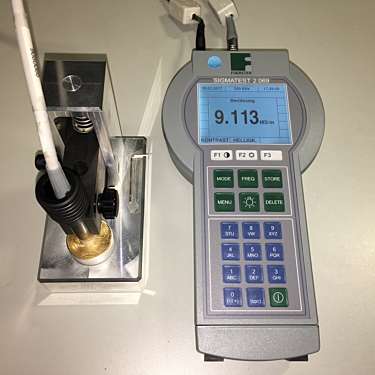Purity of Gold

Fineness mark on an old Good Delivery gold bar.
Image source: LBMA GDL website
How can the purity of gold be expressed? Let us, as Elizabeth Barrett Browning said, count the ways.
Percentage
Parts per hundred (by weight) of pure gold in an alloy. Percentage purity, expressed to four significant figures, is sometimes seen on old gold bars, though the LBMA Good Delivery system requires purity to be expressed as fineness.
Fineness
Parts per thousand (by weight) of pure gold in an alloy. In the gold market, it is most commonly expressed to four significant figures (e.g., 999.9), though the decimal point is often omitted. Five significant figures may be used for high-purity alloys (e.g., 999.99), but it is very rare for refiners to claim that they have produced such exceptionally pure gold.
These finenesses are often expressed in words rather than digits (e.g., four-nines or five-nines) especially when spoken but also sometimes when printed.
The results of individual assays on gold alloys are usually initially expressed to five significant figures and then rounded to four figures. The LBMA Good Delivery system has rules for rounding five-figure gold assays to four figures. In most cases, if the fifth figure is a 6 or greater, the result is rounded up. So an assay of 997.46 would be rounded up to 997.5. There are three fineness levels where rounding up is not allowed: 995, 999.9 and 1,000. So, for instance, an assay of 994.99 would be expressed in four figures as 994.9, rather than being rounded up to 995.0.
Caratage
The ancient but still used system of carats or karats for describing the purity of gold is based on 24 parts by weight. In spite of man’s ten digits, which led to the decimal numbering of ancient Rome, the system of weights based on 24 parts had a big advantage – the facility with which quantities could be divided into halves, quarters or eighths.
In the UK, the Hallmarking Act 1973 ended the assay offices’ practice of marking gold with carat marks and, instead, a three-figure fineness is now used as part of the hallmark, for example, 375 (9 carat), 585 (14 carat), 750 (18 carat) and 916 (22 carat).
Until the French Revolution and the resulting development of the metric system of weights and measures, gold coinage was almost synonymous with 22-carat gold. The formula for making the coinage alloy was 11 parts gold to 1 part base metal (or silver). After the Revolution, French gold coins (and eventually those of most other countries) were produced with a fineness of 900. The main exception was the UK (and its imperial appendages), which continued to produce 22-carat coins. In the early years of the London Gold Market’s Good Delivery List, coin bars produced by simply melting such coins were accepted as Good Delivery, as long as their fineness was in the range of 899 to 901 or 915½ to 917.
In terms of orthography, British English prefers ‘carat’, whereas in the United States, ‘karat’ is preferred. But almost everyone uses K or k in the abbreviation (e.g., 18K gold).
Elemental Analysis of Impurities
Until the middle of the 20th century, the most practical way of accurately determining the fineness of gold alloys was by using the direct gravimetric method of fire assay. But the gradual adoption of spectrometric analysis for measuring the contents of impurity elements in alloys offered an alternative approach – the determination of assay fineness by difference. In other words, the fineness is calculated by subtracting the contents of all the impurities (expressed as parts per thousand) from 1,000. For higher-purity alloys, the impurity levels are small and are usually expressed in parts per million (ppm) or as purist followers of the SI units might say, mg/kg. So an alloy with a total of 100 ppm of impurities has a fineness of exactly 999.9.

